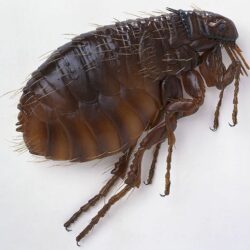דף הבית // Fleas Control

תוכן עניינים
ToggleFleas have a complete lifcycle. This is significant when performing flea control since exterminators should address all stages, even those that are immune to pesticides. These stages include the egg stage and the pupa stage in which the flea is protected by a shell or a cocoon and is unaffected by environmental changes.
A complete lifcycle of an insect means that the insect has four developmental stages:
Egg – In this stage in the flea’s lifcycle it is protected by the eggshell and therefore suffers less damage from pesticides.
Larva – In this stage, the flea is not protected and is sensitive to pesticides containing Pyrethroid.
Pupa – Similar to the egg stage, in the pupa stage the flea is relatively protected from pesticides.
Maturity – This is the final stage in the flea’s lifcycle, in which it bites and causes itchiness, and in which it is most sensitive to pesticides containing Pyrethroid.
The Biology of Fleas:
The female flea feeds on blood which it requires in order to produce eggs. We usually encounter it in our daily life as it feeds on the blood of various pets such as dogs, cats, hamsters, rabbits, birds, mice and rats (the latter caused the big outbreak of the plague in 18th century Europe, which led to the deaths of tens of millions of people).
After mating with the male and sucking blood from its hosts the female lays eggs, usually on the host. Eggs that are not covered with adhesive usually fall off and scatter in the host’s surroundings – kennel, house, garden, yard, sofa, etc. – where they will go through the next developmental stages (egg, larva and pupa). After emerging from the pupa, the lifcycle starts all over again.
Several days from the time the eggs are laid (the duration depends on environmental temperature) the eggs hatch and the larvae feed on organic leaves (dried blood, hair, dried skin flakes) and within a few days to a few weeks (again depending on temperature) the larvae will turn into pupas before the final stage in their lifcycle – maturity.
In Israeli households we usually encounter cat/dog fleas, which cause great inconvenience to both pets and humans, and in case of an allergy it can cause phenomenon more severe than itching and bites.
for proper and effective flea control it is necessary to take care of the various pets with veterinary pesticides only; vacuum all the couches, mattresses, carpets, etc., and only then perform flea control.
Flea control should be done using pesticides that combine two active ingredients:
Pyrethroid – pesticide that mostly affects mature fleas and larvae.
IGR (Insect Growth Regulator) – pesticide the mostly affects the relatively protected egg and pupa and prevents them from developing into the next stages.
Detecting the presence of fleas is usually by noticing bites on the legs, and if there is a pet, the animal’s obsessive and aggressive scratching throughout the day.
Additionally, if fleas are present you might notice tiny black bugs jumping around, which do not “crunch” when squishing them with your finger.
Juk Barosh – Flea Control
Elad Uri, Agronomist and Certified Exterminator
Exterminator License Num. 1803
If you have any question, please contact us at:
054-4603208; 050-2870048
Follow us:
https://www.facebook.com/jukbarosh/ / ג’וק בראש הדברה נכונה
www.twitter.com/JukBarosh / @JukBarosh
www.youtube.com/user/jukbarosh
With decades of experience, we can guarantee full customer satisfaction, a policy of responsibility for every extermination.
Pest control works are carried out by certified and professional workers with a pest control license from the Ministry of Environmental Protection.
We provide a quick response to our customers and prioritize prompt handling of the nuisance from the moment of identification.